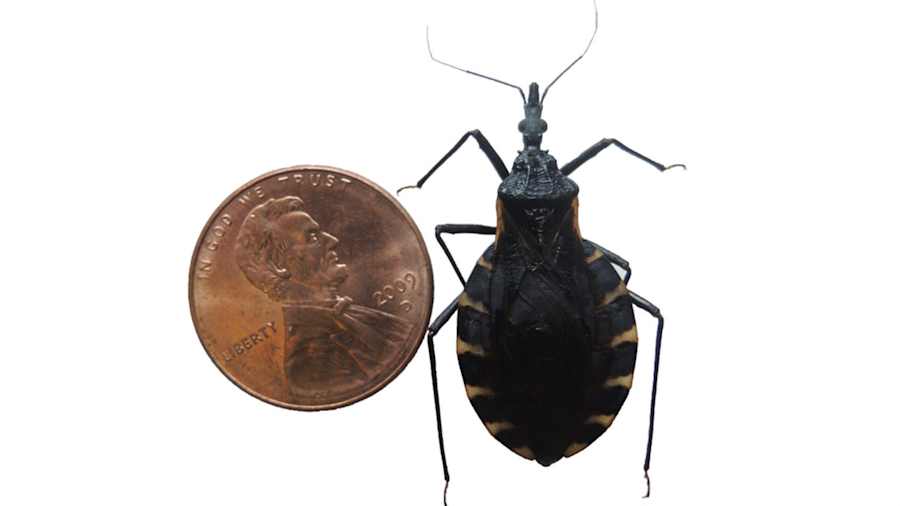The name sounds cute, but there is nothing romantic about the “kissing bug.”
The blood-sucking triatomine bugs carry a parasite that can infect people with Chagas' disease, which can lead to chronic heart disease in about one-third of those infected, according to the American Heart Association (AHA), and the bugs are making their mark in the United States.
Recommended Videos
AHA said Chagas' disease has spread to areas where it was not traditionally seen, including the United States, where it is estimated that 300,000 people are currently living with the disease. In fact, Chagas' disease is responsible for more than seven times as many disability-adjusted life-years lost as malaria.
Symptoms
Symptoms of Chagas' disease include:
- Fever
- Headache
- Body aches
- A rash at the site where the parasite entered the body
- Swelling around the eyelids
If that’s not enough to make you quiver, there’s more.
Why is it called a "kissing bug"?
After injecting a numbing agent in their saliva, the nocturnal bug typically feeds for 20 to 30 minutes -- often as you sleep -- near the mouth or eyes, and the host is completely unaware they’re being bitten.
The parasite — Trypanosoma cruzi, or T cruzi — is transmitted when feces from the “kissing bug” enters the skin through a bite or in the eye. The disease can also be passed through contaminated drink or food, from mother to fetus and through blood transfusions or organ transplants.
In some, the saliva may cause an allergic reaction, leading to severe redness, itching, swelling, welts, hives or, in rare cases, anaphylactic shock.
Chagas' disease
To make matters worse, those who contract the disease can develop heart disease, including:
- Heart failure
- Stroke
- Life-threatening ventricular arrhythmias
- Cardiac arrest
Identifying "kissing bugs"
So what should you be on the lookout for? Most of the bugs, which range from about 3/4 to 1 1/4 inches in length, have a very characteristic band around the edge of the body that is striped with orange or red markings, Texas A&M University Agriculture and Life Sciences Texas Chagas Task Force said. However, since there are 11 different species of the kissing bug, some take on different traits.

[Click here to see additional types of "kissing bugs."]
Where are the bugs?
The Centers for Disease Control and Prevention said because indoor structures in the U.S. are built with plastered walls and sealed entryways, the kissing bugs rarely infest indoor areas of homes.
So where are the bugs typically found?
- Beneath porches
- Between rocky structures
- Under concrete
- In rock, wood and brush piles or beneath bark
- Rodent nests or animal burrows
- Outdoor dog houses or kennels
- Chicken coops or houses
If found inside, they are likely to be:
- Near pet resting areas
- In areas of rodent infestation
- In and around beds and bedrooms, especially under or near mattresses or night stands
Combating the "kissing bug" and Chagas' disease
Dr. Michael Merchant, with the Texas A&M AgriLife Extensions Service, said the bugs are nocturnal and may be attracted to nighttime lights, therefore turning them off around houses and kennels is recommended. It should be noted that, it will not ensure the bugs will not be able to make way into homes.
Other ways to be vigilant in keeping your home and family safe from the "kissing bug" include:
- Seal any gaps or cracks in your home, including around any openings for utility lines, plumping pipes and cables
- Replace any damaged weather stripping
- Repair damaged screens on windows, attic vents and crawlspace vents
- Make sure exterior doors are tightly closed
- Clean animal beds regularly
- Inspect your pets when they come inside the home from outside
- Move piles of wood, rocks and leaves away from the home
Should someone find a kissing bug, it's imperative that it not be touched, as the parasite occurs in the feces, and its body may be contaminated. Instead, use a small plastic bag or a glove.
The AHA said if caught early, an infection can be cured with medications that have a 60 percent to 90 percent success rate.
“Early detection of Chagas' disease is critical, allowing prompt initiation of therapy when the evidence for cure is strong,” said Dr. Caryn Bern, professor of epidemiology and biostatistics at the University of California in San Francisco.
Anyone who suspects they may have Chagas' disease should consult a health care provider.




